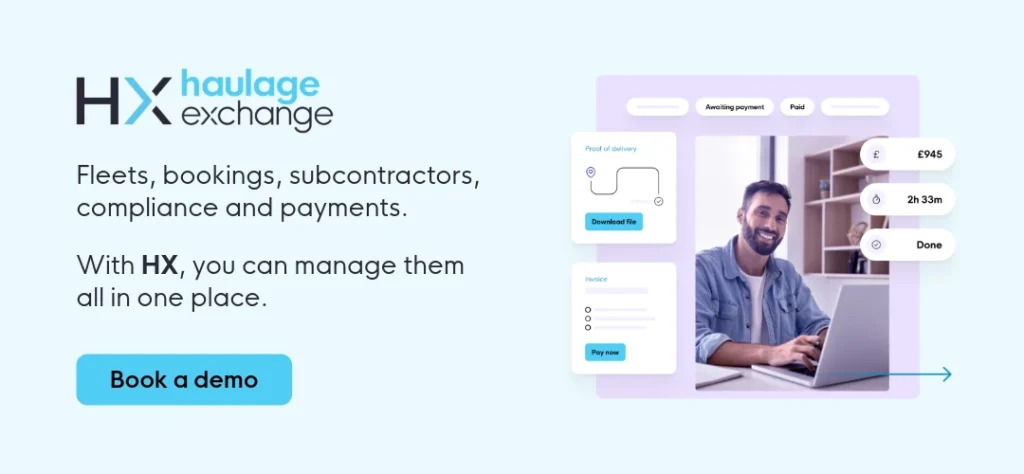Managing haulage drivers effectively is central to running a successful haulage business. For fleet managers, handling recruitment, scheduling, driver well-being, and performance can be challenging but rewarding. With the right strategies, you can improve safety, reduce costs, and keep your drivers motivated.
This guide covers tips on managing haulage drivers, from recruiting to training, supporting well-being, and using technology to make day-to-day operations more efficient.
What we’ll cover
Recruiting the right drivers for your fleet
Hiring skilled and reliable drivers is the first step in effective driver management.
When you bring on the right drivers, your fleet benefits from reduced turnover, better safety, and a stronger team dynamic.
Identifying skills and qualifications
When recruiting drivers, focus on qualifications and traits that show professionalism and reliability.
Look for candidates with HGV licences and a solid driving record. A clean safety history, strong communication skills, and the ability to handle long hours help drivers perform well under pressure.
If you’re starting a haulage company, building a solid team from the beginning helps set high standards for safety and customer satisfaction. A focus on hiring the right talent means fewer issues down the road and a stronger foundation for growth.
Attracting quality drivers in a competitive market
Attracting skilled HGV drivers is increasingly challenging for many haulage companies, especially smaller operators.
Larger companies like DHL, Amazon, and Tesco also need HGV drivers, often offering higher wages and extensive benefits. Competing with these giants makes it hard for smaller and medium-sized companies to attract qualified drivers.
In the UK, demand for HGV drivers has surged in recent years, with around 60,000 open HGV driver positions as of 2023, according to industry reports. Meanwhile, the number of qualified HGV drivers remains low, with an estimated 300,000 drivers for the 400,000 roles needed across the sector.
This imbalance leaves haulage companies struggling to recruit and retain drivers.
Offering a competitive package with meaningful perks can help you stand out from other haulage companies. Here are some effective perks to consider:
- Health and wellness benefits: Offering health insurance, driver mental health resources, and wellness programmes shows that you prioritise driver well-being.
- Paid HGV driver training: Covering costs for certifications and career development programmes appeals to drivers focused on growth.
- Referral bonuses: Incentivise your current drivers to refer other skilled drivers by offering bonuses for successful referrals.
- Fuel and performance bonuses: Drivers who achieve fuel efficiency or safe driving targets earn financial rewards, encouraging a strong safety culture.
- Flexible scheduling: Options that allow drivers to balance work with personal commitments, especially during peak periods, boost retention.
Using industry-specific platforms, networking events, and offering referral incentives can help you attract drivers more effectively.
When drivers feel valued and supported from the start, they’re more likely to join your team and stay long-term, which positively impacts your fleet’s stability and performance.
Managing haulage drivers to reduce fatigue and improve well-being
Driver fatigue is a serious risk, impacting both safety and performance.
Managing haulage drivers well means setting reasonable schedules, supporting mental health, and planning for peak seasons without overworking your team.
Balancing hours and managing road risk
Scheduling to allow sufficient rest is an important step in managing road risk.
Telematics systems help fleet managers track driving hours, ensuring drivers get breaks to stay alert. During seasonal demand periods, it can be tempting to ask drivers to take on more hours, but this can lead to fatigue and safety risks. Balancing workloads over these periods keeps drivers safer and prevents accidents caused by exhaustion.
Using telematics data to monitor driving hours gives you a clear view of driver performance and helps reduce risks on the road.
Prioritising mental health and wellness
Supporting mental health improves driver retention and job satisfaction.
Haulage companies can offer resources like wellness programmes, mental health support, and regular check-ins. Providing access to stress management tools or wellness check-ups can make a big difference to your drivers’ well-being.
Building a culture that values mental health not only reduces turnover but also improves performance. When drivers feel supported, they’re more focused and motivated on the road, which translates to safer journeys and better service for customers.
Reducing burnout with expanded capacity during peak season
During peak periods, such as the holiday season, drivers often face increased workloads, which can lead to burnout.
One effective way to manage peak seasons without overwhelming your team is to use Haulage Exchange to find subcontractor haulage vehicles. HX provides access to a network of reliable subcontractors, allowing you to expand your capacity temporarily and avoid overloading your core team.
Hiring subcontractors during these busy times lets you manage high demand without compromising driver well-being. Expanding your fleet with HX also reduces delivery delays and improves customer satisfaction, while ensuring your main drivers stay rested and ready.

Training and developing drivers for consistent performance
Ongoing training helps drivers stay safe, informed, and efficient. Well-trained drivers improve fleet performance, reduce fuel costs, and create a culture of safety within your business.
Core training areas for safe driving
Regular HGV driver training updates are essential for consistent, safe driving.
Focus areas for training include defensive driving, safe cargo handling to avoid cargo theft, and fuel-efficient driving techniques. Training on these skills keeps drivers alert and helps them respond better to hazards on the road.
Incorporating fuel-efficient driving techniques into training can also help reduce your fleet’s fuel consumption. When drivers learn fuel-saving strategies, it not only benefits your budget but also supports a more sustainable operation.
Motivating drivers with effective incentives
Providing incentives keeps drivers motivated and focused on delivering their best.
A well-structured incentive programme encourages safe driving, loyalty, and long-term retention.
Rewarding safe and efficient driving
Incentives based on safety, fuel efficiency, and punctuality give drivers specific goals to aim for.
For instance, you could offer bonuses for drivers who hit fuel-saving targets, as this directly impacts costs and supports sustainability. Other options include paid time off or monthly rewards for consistent safety records.
Rewarding safe and efficient driving reinforces positive behaviour, helps with fleet management, and strengthens the connection between drivers and the company.
Building a positive work culture
Creating a positive work culture involves more than just offering rewards.
Open communication, regular feedback, and a supportive team environment all play a role in keeping drivers engaged. A company culture that values input and feedback helps drivers feel connected and valued.
Encouraging drivers to provide suggestions and recognising their hard work creates loyalty, reduces turnover, and contributes to overall job satisfaction.
Using technology to support driver management
Modern technology offers tools that support drivers, improve scheduling, and keep fleet operations running efficiently.
By incorporating tools like carrier management software and HX, you make it easier for drivers to perform well and meet expectations.
Carrier management software for driver support
Carrier management software helps fleet managers track driver performance, monitor schedules, and manage routes.
This software centralises driver data, allowing you to monitor their progress and adjust schedules as needed. Real-time data access also helps drivers make informed decisions, such as avoiding traffic or adjusting to weather changes.
With software that supports efficient scheduling, driver workloads become easier to manage, and you gain clearer insights into your fleet’s overall performance.
Haulage Exchange for live tracking and return loads
Using Haulage Exchange provides fleet managers with live tracking and access to return haulage loads. HX allows you to manage driver routes more efficiently, helping reduce empty miles and improve fuel usage. By filling empty trucks on return journeys, you improve overall efficiency and cut unnecessary costs.
HX’s Freight Vision also supports real-time driver management, helping you keep a clear view of each journey. This tool can support driver performance by allowing for faster adjustments and reducing time spent on the road.
Conclusion
Effective driver management is about building a strong team, supporting their well-being, and providing the tools they need to succeed.
By focusing on managing haulage drivers with good recruitment, consistent training, and reliable technology, you set your fleet up for safer, more efficient operations.
When drivers feel supported, trained, and appreciated, they’re more likely to perform well, reducing costs and boosting customer satisfaction.
Investing in these practices leads to better performance, safety, and loyalty across your fleet.




